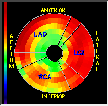[Menu] [Previous] [Next]
TUTORIAL: Clinical PET - Cardiology
Use the "Menu" button to jump to the Let's Play PET Main Menu or click on the Next and Previous buttons to proceed sequentially through the topics and tutorials. Or, you can return to the Department of Molecular and Medical Pharmacology's Home Page.Contents:
Topics:
Single Vessel Disease

Click on image above to view full-size image.
The re-sliced NH3 perfusion and FDG metabolism images shown above are relatively normal. There is homogeneous distribution of tracer, without any significant defects in any of the imaged planes.

Click on image above to view full-size image.
The polar maps derived from the previous images are shown above. Note that they are consistent with a homogeneous flow pattern, as well as a relatively homogeneous metabolism pattern. The scales for each polar map are shown, and they differ. The hotter yellow areas in the lateral regions of the metabolism polar map are not significantly different from normal.


Click on one or both of the images above to view full-size image(s).
The same patient is now given a stress-perfusion study to look for any perfusion abnormalities under states of increased myocardial demand. The results of this study, shown above, reveal a small defect in one of the planes (look for a red arrow in the series of images in the bottom row). The polar map shows the same defect (the green pixels) in the antero-septal region.
Credits
Material for this section was kindly provided by:Johannes Czernin, M.D.
Dept. of Molecular and Medical Pharmacology
UCLA School of Medicine
Heinrich R. Schelbert, M.D., Ph.D.
Dept. of Molecular and Medical Pharmacology
UCLA School of Medicine
[Menu] [Previous] [Next]